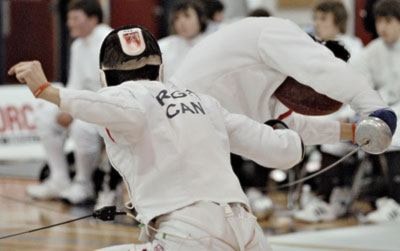Karl Gardner roared.
The Ontario fencer had just struck his opponent with a sword.
“En Garde,” said the judge.
“Alle.”
This bout, Gardner got jabbed.
Another bellow filled the Vanier high school gym.
It was the middle of the Canada Winter Games fencing round robin, and the Gardner fight was one of 10 taking place in the school’s two gyms on Wednesday.
But it was drawing the most attention.
Snickers erupted from the crowd as Gardner hollered and howled.
He was still yelling, sword outstretched, when he charged forward to shake his opponent’s hand after wining the round.
Gardner’s opponent looked taken aback.
The roaring really gets the adrenalin pumping, said Gardner.
“It pumps you up, carries you, intimidates your opponent and gets the crowd going,” he said.
“I scream out the excitement if I get it and let out the aggression if I don’t.”
Yelling can also influence the judges if a match is close, said Manitoba fencer Colin Weinheimer.
Usually matches are called by the red or green lights that flash when a competitor is hit with a sword.
But when both lights flicker almost simultaneously, it’s the judge’s call.
And, apparently, yelling helps.
Dressed in white, with dark mesh masks hiding their faces and a recoiling wire attached to their shiny tunics, the fencers looked more like space-age robots than people.
From their tunics, wires are also attached to their masks and run down their sleeves to connect with the swords.
When one of the swords touches the other fencer, it completes a circuit that sets off a light, indicating who got the point.
But the system’s not foolproof.
Tunics can get unplugged, annulling possible points. The wiring in swords can fail.
And some sweaty fencers are in for a shock.
“If you’re unlucky, you sweat and the electricity starts shocking your arms,” said Nova Scotia fencer Eric Dilcher.
“That happened to me once, and the tingling makes your muscles tighten and affects your game.”
Dilcher had just won his match in overtime, and got a hug from “team mom” Trudy Sangster.
There are 18 fencers on the Nova Scotia team, and nine parents travelled to Whitehorse for the Games.
“We all support our kids,” said Sangster, between bouts of yelling and cheering.
The Nova Scotia mom has two kids who fence.
She blames Star Wars.
“They started out with light sabres and sticks,” she said.
“And I thought it would be an interesting sport — I wasn’t going to put them in hockey.”
When Sangster’s boys were using club equipment it was a relatively cheap sport.
But now, her son Christopher is travelling with five swords, each worth more than $100.
“They break down all the time,” she said.
“And the kids aren’t particularly careful with them.”
Wiring is not the only thing that can fail on a sword.
Both foils and epees, two types of swords, have tips that compress when they hit their targets.
When they compress, it connects the wires and triggers the light.
In epee and foil fights, only hits with the tip of the sword count for points, while in sabre bouts anything goes.
“You can slash, you can go for the head, you can hit anywhere above the waist,” said international judge and past national team member Michel Dessureault.
In foil, fencers can only score points if they stab their competitor’s torso.
But in epee the whole body is fair game.
Fencing is a lightning-fast sport.
But it’s also tactical.
“It’s a whole bunch of mind games,” said Dessureault.
“It’s like playing chess at 100 miles an hour.
“You have to figure out your opponent before he figures you out.”
On the sidelines, three Maritimes fencers were watching the matches.
“You have to watch your opponents for habits before you fight them,” said Prince Edward Island’s Bethany Hughes.
“Some parents even tape the matches, but that’s a bit extreme,” said Hughes’ teammate Alexis Bulman.
Different personalities are attracted to different weapons, said Dessureault.
“In sabre it’s attack, attack, attack,” he said.
“While in epee you’re more of a tactician — you attack less, because if you miss, they won’t miss you.”
Sabre bouts last less than a minute, while epee fights can be upwards of three.
And foil falls right in the middle.
“If you’re aggressive you go to sabre; if you’re really patient you go to epee, and foil is a happy medium,” said Dilcher.
While foil attracts the even keeled, epee attracts the pirates and romantics.
“I feel like a pirate, and I love Johnny Depp,” said Nova Scotia epee fighter Jessica Trites.
“I saw The Princess Bride and thought it was so cool and unique,” added Saskatchewan’s Naila Kuhlmann.
With bright green hair, Kuhlmann and a number of her teammates stood out.
“I enjoy dyeing my hair, and we wanted to show off a bit,” said teammate Neaera Deptuch, sporting a lime-green do.
With coloured hair, movie influences and wired suits, fencing has entered the modern age.
But it still retains its Old-World charm.
“A member of my fencing club, who was in his 60s, fenced seven real duels,” said Dessureault.
One was to the death, but the rest were to “first blood.”
Fencing has been upholding honour since cavemen began beating each other with sticks, said Dessureault.
Once metal was discovered, weapons were crafted, and over the years these got lighter and lighter.
“Fencing became the sport of nobles,” he said.
“And it was part of the first Olympic games in Athens.”
The sport hasn’t changed much, added Dessureault.
“Only people don’t die as much.
“Everybody has taken up a stick as a kid, whacked around and played Zorro, and we get to do it with real swords.”
